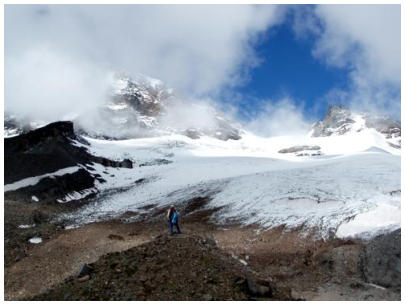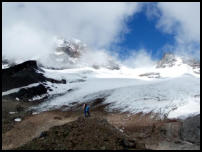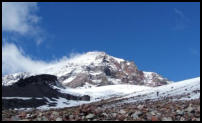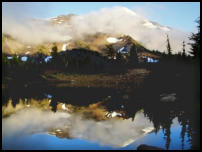





Photographer
OR, WA, ID, NV, AZ, UT
541/350-6189

Pole Creek to
Obsidian











This
trip
really
began
two
years
ago
after
a
three-day
hike
into
the
Obsidian
area
of
the
Central
Oregon
Cascades.
My
hiking
partner,
Dean
Dowd,
asked
"Tim,
what
would
you
do
differently
on
this
trip?"
"I
think
I
would
like
to
come
in
from
the other side" was my reply.
So
a
few
more
miles
down
the
trail
and
a
couple
of
years
older,
three
of
us
started
in
from
the
Pole
Creek
trail
head
near
Sisters,
Oregon.
The
first
day
Aaron
Kramer
(57),
Dean
Dowd
(77)
and
myself
(57)
hiked
five
miles
up
to
a
small
meadow near the foot of the Hayden glacier. We had an elevation gain of 1750 feet.
If
you
decide
to
hike
our
trail,
take
care
in
locating
where
the
smaller
trail
cuts
off
from
the
main
trail.
The
trail
we
took
was
the
second
trail
(no
number)
off
of
trail
number
4074.
We
hike
up
this
trail
to
approximately
the
6950
foot
level
and then turn off the trail due south to a small meadow (7000 ft.) where we camped for the evening.
With
the
assistance
of
the
guys
I
set
up
a
Snow
Peak
"Penta"
tarp
to
keep
the
elements
off
us
that
night.
After
a
little
exploring
around
the
area
and
a
dinner
of
Knorr's
excellent
Tomato
&
Basil
soup,
hot
dogs,
some
Triscuits,
and
a
little
cheese and some gorp for dessert, I turned in for the evening.
The
moon
went
down
early
and
we
were
blessed
with
a
star-studded
night.
The
star
light
brilliance
is
something
you
can only get with elevation; up here there is no pollution to cloud your vision of the stars.
The
next
morning
we
found
a
half-inch
of
frost
on
the
tarp,
but
not
on
our
sleeping
bags,
(except
the
foot
of
my
sleeping bag). Only those items left outside the tarp got touched with frost.
After
breakfast
we
packed
up
and
headed
up
the
mountain
toward
the
Hayden
Glacier.
We
climbed
the
foot
of
the
glacier where I put my instep cramps on and we head across the ice and snow.
Aaron
was
the
first
notice
the
crevasses
on
the
south
side
of
the
glacier
(he
was
trapped).
When
we
noticed
our
predicament,
we
started
carefully
moving
to
the
north
side
of
the
glacier,
where
there
seemed
to
be
fewer
crevasses.
Aaron
worked his way clear. Dean pulled himself out of a crevasse. And I started testing the ice with my walking sticks.
When
we
reached
the
north
edge,
we
found
that
a
couple
of
hikers
had
preceded
us
up
the
edge
of
the
glacier
and
we
followed their footsteps all the way to the top.
Topping
out
at
the
saddle
between
the
middle
and
north
we
found
that
"duck-footed"
Kramer,
"out-of-breath"
Dowd,
and
"ol"
lame-footed"
Satterfield
didn't
have
the
will
the
tackle
the
Middle
Sister.
Never
mind
that
it
had
snow
four
or
five
inches of snow the previous days and we didn't have the correct equipment to safely negotiate the slopes up to the top.
After
a
little
lunch
we
headed
down
the
Collier
Glacier
hiking,
and
sliding
on
our
derriere
(unintentionally,
and
we
slid
on
a
few
other
parts
also).
We
reached
a
point
where
we
had
to
negotiate
an
icy
ridge
to
transverse
into
another
ice
field,
we
started
up
I
heard
"OOP's"
and
as
I
turned
I
saw
Aaron
sliding
toward
the
bottom
of
the
incline.
After
Aaron
made
two
more
"OOP's"
we
all
made
the
crest
of
the
ridge
and
started
down
toward
Arrowhead
Lake.
(We
scored
Aaron
7.5
out
of
a
possible ten points for lack of form.)
This
writer
thought
he
could
save
a
little
time
by
sliding
down
on
his
jacket
to
the
bottom.
"OOPS,"
-
error,
yes
I
was
saving
time,
yes
the
speed
was
a
lot
of
fun,
and
yes
the
rubble
at
the
edge
of
the
snow
racing
toward
me
like
a
mad
dairy
bull
across
his
pasture.
I
knew
I
was
in
trouble
when
I
couldn't
find
the
breaks.
I
dug
in
all
I
had
(hands
and
feet)
and
slow
down to allow my legs to absorb the rocks without too may bruises. OUCH!
Following
other
hikers
who
also
didn't
know
the
route,
we
finally
arrived
late
evening
at
Arrowhead
Lake.
We
set
up
camp, got a quick dinner and were soon fast asleep under another starry night.
About
7:00
that
evening
my
legs
started
to
cramp.
I
had
taken
all
the
usual
precautions,
extra
calcium
&
lots
of
Gatorade
,
but
my
leg's
muscles
started
taking
turns
cramping.
The
Gracilis
muscle
would
say
to
the
Vastus
Lateralis,
your
turn,
the
Vastus
Lateralis
would
do
his
thing
and
pass
off
back
the
Gracilis
who
pass
the
pleasure
down
to
the
Peroneus
Brevis,
who
would
get
his
buddy,
the
Extensor
Digitorum
Longus,
to
take
up
the
cause.
This
would
go
on
for
30
minutes
of
so,
each
of
the
muscles
in
my
legs
taking
turns,
after
they
seized,
and
had
a
good
laugh,
the
muscles
would
take
a
break
and
wait
45
-
60
minutes
and
start
all
over
again.
Finally,
around
6:00
in
the
morning
they
quit
partying
and
I
got
a
couple
hours of sleep before it was time to get myself out of bed.
The
next
day
we
decided
to
move
camp
about
half
mile
to
the
South.
That
day
we
lounge
around
camp.
It
was
great
to
have allotted an extra day for just resting and a little area exploration.
Our
maps
show
a
trail
down
to
Sister
Springs
and
Obsidian
Falls,
but
we
weren't
exactly
sure
of
where
our
camp
was
(located
on
the
map).
With
a
little
map
and
compass
work
by
sighting
off
of
the
Husband
and
Middle
Sister,
we
located
our
position on the map and then we were able to walk down to the trail.
The
next
day
it
was
easy
walk
down
to
the
springs
and
then
to
the
falls.
This
is
a
beautiful
part
of
the
middle
Cascade
Range. It was about 4.6 miles Obsidian trail head.
The
vistas
on
this
trip
were
great.
I
photographed
until
I
was
running
low
on
camera
memory.
I
took
photos
all
the
way
up
then
down
the
trail.
Soon
I
was
searching
the
memory
chip
for
an
image
to
kill
so
that
I
would
have
enough
room
for
a
new shot. Moral: Always take enough film or memory for your camera.
I
recommend
this
hike;
it
has
great
vistas
and
is
a
bit
of
a
challenge.
The
hike
requires,
if
you
were
in
good
shape,
two
days,
but
why
hurry
when
Mother
Nature's
beauty
is
all
around.
Take
your
time,
four
or
five
days
is
better
(if
you
have
the
time).
Equipment:
The
gear
in
my
Coleman
pack
included:
Sierra
Design
Delta
sleeping
bag,
a
silk
bag
liner
from
Cocoon
(which
really
helps
when
the
thermometer
takes
sudden
dip.
In
the
cool
high
country
it
always
goes
with
me.
A
Therm-a-
rest
air
mat,
for
me
it's
nice
to
keep
my
bad
feet
on
a
comfy
mattress.
I
carried
the
Snow
Peak
"Penta"
for
overhead
shelter
and
brought
a
30"
wide
piece
of
3-mil
plastic
for
ground
cloth.
I
think
I'll
try
40
inches
next
time.
The
Penta
slept
all
three
of us.
For
cooking
I
took
a
110-gram
gas
canister,
the
Coleman
F1
auto
start
stove,
stove
works
great
but
the
piezoelectric
device
failed.
I
keep
a
lighter
handy
just
for
this
reason.
The
Snow
Peak
Ti
(titanium)
Solo
kit
is
light
and
works
well
for
cooking.
I
took
their
Ti
spoon.
I
found
that
I
needed
an
additional
container
for
the
cook
kit
so
I
have
since
added
a
plastic
cup that fits perfectly within the solo kit.
This
is
a
great
hike
to
take
your
trekking
poles
on.
I
had
my
Swix
CT4s
along
and
it
made
climbing
and
descending
the glaciers a lot easier (and safer). The CT4s are a great lightweight and strong walking stick.
On
my
feet
were
a
pair
of
Vasque
Breeze
GTX
XCR
boots
(7462)
which
allowed
me
to
hike
all
day
and
took
real
good
care
of
my
(Dr.'s
quote)
"worn-out"
ankles.
I
pair
the
boots
with
an
extra
insole
(Ultra2)
from
Shock
Doctor
.
The
boots
were
good
at
kicking
steps
in
to
the
glacier.
I
started
using
the
Shock
Doctor
insoles
after
my
feet
"fell
apart,"
so
to
speak.
The
heal
cup
stabilizes
my
heal
in
one
place
and
keeps
my
feet
from
hurting.
The
composite
foam
padding
absorbs
shock
and
provides
cushioning
for
my
bone
spur,
allowing
new
to
hike
most
of
the
day
without
pain.
Also
my
feet
don't
tire
as
fast as they would normally tire. (I'm also testing a couple of other Shock Doctor products, I'll report on those later.)
I
took
soup
and
wieners
the
first
night,
Natural
High's
Spicy
Thai
Chicken
with
Broccoli
&
Noodles
(good
stuff)
for
the
second
night
and
for
the
final
evening,
Backpacker's
Pantry
Beef
Stroganoff.
I
generally
like
Beef
Stroganoff
but
even
after
adding
a
little
salt,
well
--
just
give
this
one
2
1/2
stars
out
of
5.
Breakfast
I
generally
make
a
helping
of
gruel
(oatmeal with raison and dried cranberries). Lunch is a little gorp and dried fruit.
For
a
camera
bag
I
chose
an
old
Coleman
waist
pack.
The
little
pack
will
hold
my
camera,
batteries,
extra
memory
(film), plus their is room for my Silva Ranger compass and map.
The total amount of weight that I carried was 22 pounds including camera.
Aaron
carried
20
pounds.
In
his
new
GoLite
pack
he
put
a
Coleman
sleeping
bag.
Aaron
carried
a
cheap
blue
camping
mat
and
tarp
from
hardware
store.
We
used
the
tarp
under
the
'Penta."
He
used
an
alcohol
stove
and
tin
can
to
cook
in.
(It
works and is cheap to operate.)
Dean
carried
17.5
pounds
in
his
homemade
pack
sack
(He
has
since
replaced
the
pack.).
He
also
carried
his
Snow
Peak
Giga
power
(GS100A)
.
He
likes
it
because
it
always
works
and
simmers
well.
For
sleeping
Dean
also
carried
a
cheap
blue
camping mat that kept him off the ground (and that's about all).
Contact
Info:
www.coleman.com,
www.cascadedesigns.com,
www.snowpeak.com,
www.vasque.com,
www.nordicwalking.no/,
or
www.swixsport.com,
www.golite.com,
www.naturalhigh.com
,
www.designsalt.com
backpackerspantry.com
.
by Tim Satterfield